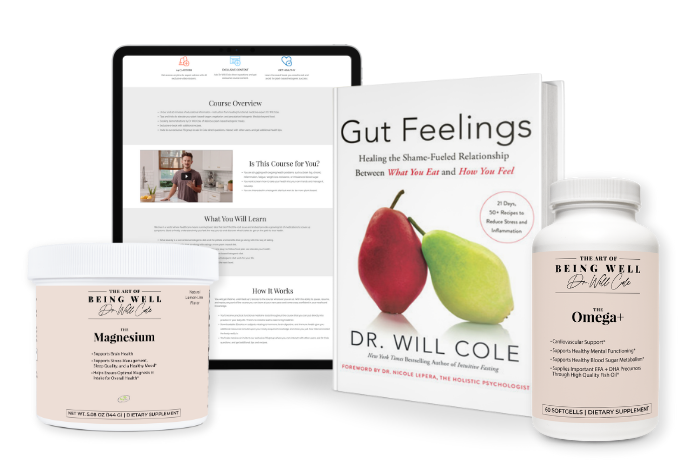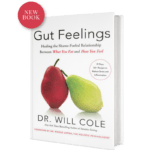A Functional Medicine Expert’s Guide To Beating A Cold + Boosting Immunity

Inevitably, even the healthiest of individuals will get sick. In fact, research estimates (1) that annually there are around 1 billion cases of the flu around the world, and 1 billion (2) cases of the common cold in America alone. The symptoms can creep up on you and next thing you know you are on the couch binging on Netflix with a box of tissues. We want to do everything in our power to prevent getting sick therefore, we need to keep our immune system strong. Understanding how our immune system works and is interconnected with the rest of your body is the first step to a healthy immune system.
ARTICLE CONTINUES BELOW
Make Your Life a Cleanse
SUBSCRIBER-ONLY GUIDES FOR GUT HEALTH, VIBRANT ENERGY, HEALTHY FOOD & CLEAN ALCOHOL
Get FREE access to these + giveaways, recipes, & discount codes in personal emails from Dr. Will Cole.
The brain-immune axis
Your brain-immune axis is just what it sounds – a direct connection between the brain and the immune system. This axis is responsible for the link between stress and autoimmunity. For example, I have patients who started having severe immune dysfunction and autoimmune conditions following a head injury in a car accident. But why? One study (3) in the Journal of Neuroimmunology found that the cerebellum played a substantial role in modulating helpful immune cells.
Similarly, a study (4) in the Journal of Nuclear Medicine found via brain mapping, the cerebellum playing a role of attempting to activate immune function in people with cancer! In addition to the cerebellum, your brain’s cerebral neocortex has been found (5) to be another key player in the brain-immune axis.
The gut-brain-immune axis
The communication between your microbiome and brain (gut-brain axis) is pivotal for overall health. Your gut is even referred to as your second brain, and physically they actually resemble each other and both were formed from the same fetal tissue while you were growing in your mother’s womb.
Around 80% of your immune system is found in the gut, and 95% of your serotonin, the feel-good neurotransmitter, is made and stored in the intestines. You can see that as the gut affects the brain, the opposite is also true. For example, the brain has been shown (6) to regulate gut mucosal immunity.
Tools to support your immune system
While everyone is different, now that you understand the foundations of a healthy immune system, these are my favorite ways to help you amp up your immunity, naturally:
1. Support healthy methylation pathways
Methylation is sort of an antioxidant recycling process in your body, and it’s needed for optimal brain and immune health. Proper methylation produces your body’s top disease-fighting antioxidant glutathione. When your glutathione levels are low, so is your immune function. Things that deplete glutathione are:
- Toxic exposure
- Antidepressant medications
- Birth control pills
- Diabetic medications
- Antacid medications
- MTHFR gene mutations
I gauge methylation function in patients by running a lab called homocysteine. Homocysteine is supposed to be converted to glutathione via methylation. If homocysteine levels are high, methylation isn’t functioning well. Everyone should have this test run.
Homocysteine levels above 7 UMOL/L have been shown (7) to cause brain inflammation, destruction of the blood-brain barrier, and decreased immune health. The good news is that in the presence of methyl-donors like vitamin B6, homocysteine is converted to glutathione.
If you do have poor methylation, I recommend supplementing with a methylated B vitamin complex since B vitamins act as fuel for your methylation pathways. My supplement, The Methylator, is formulated highest quality B vitamins including folate (5-Methyltetrahydrofolate), B6 (Pyridoxal 5′-phosphate), B12 (methylcobalamin), B2 (Riboflavin 5′ phosphate), and anhydrous betaine (trimethylglycine) for maximum bioavailability.
2. Optimize your vitamin D levels
The sunshine vitamin is crucial for brain and immune health because it is responsible for many different brain-immune pathways (8) with low levels being linked to both autoimmune conditions and poor immune health. Optimal vitamin D levels should be around 60-70 ng/mL for most people, especially those with autoimmune conditions.
Unfortunately, Vitamin D is one of the most common deficiencies in America, making supplementation necessary for most people. My supplement, The D3-K2, takes advantage of vitamin synergy by combining two fat-soluble vitamins together - D3 and K2 - which help enhance absorption of one another.
3. Drive-down inflammation
Chronic inflammation is one of the major underlying culprits of chronic disease, but healthy inflammation levels fight off disease. To support healthy inflammation levels, it is essential to support your brain’s neurotransmitter, acetylcholine. Healthy acetylcholine activity has been shown (9) to produce optimal nitric oxide balance. Nutrients like huperzine A (10) and adenosine triphosphate have been shown (11) to activate this pathway. Providing my patients with condition-specific amounts of these nutrients helps support this brain function.
4. Improve microbiome health
For a healthy immune system, you need to have a healthy microbiome, and conditions associated with dysbiosis, or an unfavorable balance between beneficial and pathogenic bacteria (such as SIBO and leaky gut syndrome) can drastically suppress healthy immune function.
5. Eat more detoxing food medicines
An overload of toxins can put stress on your immune system. I always make conscious choices to avoid toxins as much as possible, so when it comes time to detox I need to go to the next-level. Parsley, cilantro, dandelion tea and blueberries are all easy to incorporate throughout my day. Parsley and cilantro get added to smoothies or salads and blueberries are eaten by the handful. You can always find me with a cup of tea in my hand so I’ll switch out my typical green tea with dandelion to take advantage of its B-vitamin content to help support my detoxing methylation pathways.
6. Add in adaptogens
Whenever I need a health pick-me-up adaptogens are the first thing I turn to. These natural plants and herbs provide support to different areas of your body in order to restore balance. Some are my favorites include:
- Ashwagandha: Often used to restore the immune system after being sick
- Maca: Loaded with vitamin C
- Astragalus: Contains compounds like saponins and polysaccharides that have immunomodulating effects so powerful that it is currently being looked at (12) as a possible healing tool alongside anti-tumor therapy.
7. Target your supplements
My normal diet consists of whole food sources such as wild-caught seafood, grass-fed beef, a variety of vegetables, healthy fats, and some fruit. I typically like to use medicine as my food but sometimes supplements can provide a beneficial boost.
- Vitamin C: This is the ultimate immune booster. Studies have shown (13) it can reduce symptoms by up to 30% with a typical daily dose between 1,000 and 4,000 mg.
- Zinc: When taken with vitamin C it can increase vitamin C’s immune benefits. It is responsible for increasing white blood cells and helping to fight off infections. Research shows around 75 mg can help reduce (14) the length of a cold.
- Echinacea: This herb can shorten (15) the length of your cold.
- Elderberry: Due to its rich antioxidant content, including polyphenols, elderberry has been shown to have next-level antiviral, (16) antibacterial, (17) and immune boosting (18) abilities and can reduce (19) fever and congestion by 50%.
- Bee propolis: A powerful immunomodulatory with antimicrobial properties (20) you can find this as an added ingredient in many throat sprays and lozenges.
- Vitamin B6: Helps promote (21) the production of white blood cells and T-cells needed for your body to fight off infections
8. Increase your immune-supporting foods
The second I feel a cold starting I reach for Manuka honey. This honey comes straight from New Zealand and its antimicrobial properties are out of this world. Adaptogenic mushrooms are another favorite of mine. Chaga (22) works to bring balance to the immune system. If you are dealing with a virus like the flu Chaga works great for that as well due to its antiviral properties. If you don’t like mushrooms you can get them in powder form to put in tea and smoothies but I personally love to eat them as a side with my meals sautéed with garlic and onions.
9. Gargle with sea salt water
Sea salt is more than just a meal-time seasoning. It is actually a fantastic anti-inflammatory (23) tool that can be used to ease a sore throat. I usually mix 1 teaspoon sea salt with 8 ounces of water and gargle for at least 30 seconds which helps to break up mucus and get rid of bacteria from the throat. There’s a reason why the American Journal of Preventive Medicine found a 40 percent decrease (24) in upper respiratory infections in those who gargled with salt water.
10. Cook with ginger
Next time you’re at the grocery store, pick up some fresh ginger. Not only is it one of the most affordable herbs, fresh ginger has also been shown to prevent the human respiratory syncytial virus (HRSV) (25) from attaching to cells and forming plaque in the airways. This is likely thanks to ginger’s many active compounds, including terpenoids, gingerol, and flavonoids, which work together to fend off the development of pathogenic biofilms. You can juice ginger, make fresh ginger tea, or incorporate it into recipes.
11. Add in cinnamon
Cinnamon is one of my favorite herbs; not only can it help stabilize blood sugar, but it can also work as a next-level immune system supporter. I often suggest cinnamon to my patients with blood sugar issues due to its ability to help stabilize blood sugar levels, but it also works as a next-level immunity supporter thanks to its high antioxidant content (26), which protects cells from damage. One study even showed that cinnamon can block the powerful flu strain (H7N3) (27) from entering the body’s cells. You can buy cinnamon tea, take it in a capsule, or sprinkle ground cinnamon on your yogurt, oatmeal, or into your smoothies and coffees.
12. Get some sunlight
We may be under “stay at home” orders, but that doesn’t mean we should skimp on a daily dose of sunlight if at all possible. Sunlight has demonstrated incredible healing properties; in fact, during the 1918 flu pandemic, health experts found that putting sick patients out in the sun helped deactivate the virus (28). We’re not exactly sure why sunlight is so healing, but it could have something to do with its influence on vitamin D production, which plays a role in dozens of pathways that are needed to fight off various illnesses. Not to mention, sunlight helps our body’s natural circadian rhythms, which emerging research suggests can regulate our inflammatory response (29) to viruses.
13. Book a sauna session
We all know that saunas are incredibly relaxing and comforting. But did you know that researchers have started studying the relationship between regular sauna sessions and decreased risk of respiratory diseases like pneumonia? It’s true. In fact, one study showed (30) a direct relationship between the number of sauna sessions per week and decreased risk.
So what explains these benefits? One theory is that saunas activate heat shock proteins (31) in our bodies. These proteins are produced naturally in response to stressful conditions (such as intense heat or cold) and work to increase the antiviral activity of prostaglandins (32), which are a group of lipid compounds that can inhibit RNA-based viral replication. This can slow — or even halt in some instances! — the ability of a virus to develop and grow in your body.
14. Enjoy some fresh air
We already know that sunlight was helpful during the 1918 Spanish flu pandemic, but doctors also found that open-air therapy dramatically improved the health of patients. This is something referred to as the “Open Air Factor,” where fresh air is thought to help to kill off bacteria and the influenza viruses compared to indoor air, both during the day and during the night. Decades later in the 1960s, the Ministry of Defense confirmed the therapeutic benefits of fresh air (33).
15. Turn to essential oils
I regularly diffuse oils in my home and functional medicine clinic. The use of oils for healing dates back thousands of years. When I feel a cold creeping up I go a little crazy with some specific ones:
- Eucalyptus: Not only does this oil smell wonderful it helps clear up any congestion. It can be great diffused or rubbed on your chest. It is also antimicrobial. (34)
- Tea Tree: This is a great multi-purpose antimicrobial, antifungal, (35) and antiviral oil.
- Frankincense and myrrh: There’s a reason why the wise men chose these to give to the newborn baby Jesus. Together, they have intensive antimicrobial properties. (36) And bonus, they smell amazing so I love to use them on my neck and arms even when I am not feeling sick!
- Peppermint: Great for easing nausea, alleviating headaches, and clearing up congestion.
- Lemon: This oil is very cleansing and can help with breaking up mucus and relieving stomach pains.
Note: You can purchase these oils online or in stores. When using these oils make sure to read the bottle for key areas to put the oil for the best effect and for the amount to use, dilution, whether to take them orally and other important information. The brands we recommend would be either Young Living or DoTerra which are both certified therapeutic grade.
16. Sip on bone broth
Growing up, it was likely that you were given chicken noodle soup when you were sick and there’s a reason. Bone broth is filled with nutrients like glucosamine, glycine, gelatin, and other minerals that help to heal your gut which is especially restorative after having a stomach virus like the flu. As Hippocrates says “all disease begins in your gut,” so it is essential to give your digestive system the nutrients it needs to get back to feeling 100%.
17. Drink a variety of teas
Certain herbal teas like lemon balm, (37) licorice, (38) and pu-erh (39) teas all have their own unique immune-modulating properties with other varieties containing vitamin C and other immune-boosting nutrients.
As one of the first functional medicine telehealth clinics in the world, we provide webcam health consultations for people around the globe.
Photo: unsplash.com
Start Your Health Journey Today
FUNCTIONAL MEDICINE CONSULTATIONS FOR PEOPLE AROUND THE WORLD
References:
- World Health Organization "Influenza (Seasonal)" Accessed December 2023. https://www.who.int/news-room/fact-sheets/detail/influenza-(seasonal)
- WebMD "Common Cold" Accessed December 2023. https://www.webmd.com/cold-and-flu/common_cold_overview
- Sheng-Jie Ni, Yi-Hua Qiu, Jian-Hua Lu, Bei-Bei Cao, Yu-Ping Peng et al. "Effect of cerebellar fastigial nuclear lesions on differentiation and function of thymocytes" Volume 222, Issue 1-2, P40-47, May 2010 DOI:https://doi.org/10.1016/j.jneuroim.2010.02.017
- Haim Golan, John A. Kennedy, Alex Frenkel, Ysrael Parmet, Akiva Feintuch, Ofer Levi and Yori Gidron Journal of Nuclear Medicine July 2009, 50 (7) 1072-1075; DOI: https://doi.org/10.2967/jnumed.108.061085
- Barneoud, P et al. “Functional heterogeneity of the right and left cerebral neocortex in the modulation of the immune system.” Physiology & behavior vol. 41,6 (1987): 525-30. doi:10.1016/0031-9384(87)90306-4
- Jian-Fu Zhang, Fang Zheng, The role of paraventricular nucleus of hypothalamus in stress-ulcer formation in rats, Brain Research, Volume 761, Issue 2, 1997, Pages 203-209, ISSN 0006-8993, https://doi.org/10.1016/S0006-8993(97)00257-6.
- Kamath, Atul F et al. “Elevated levels of homocysteine compromise blood-brain barrier integrity in mice.” Blood vol. 107,2 (2006): 591-3. doi:10.1182/blood-2005-06-2506
- Aranow, Cynthia. “Vitamin D and the immune system.” Journal of investigative medicine : the official publication of the American Federation for Clinical Research vol. 59,6 (2011): 881-6. doi:10.2310/JIM.0b013e31821b8755
- Tonetti, M et al. “Extracellular ATP potentiates nitric oxide synthase expression induced by lipopolysaccharide in RAW 264.7 murine macrophages.” Biochemical and biophysical research communications vol. 203,1 (1994): 430-5. doi:10.1006/bbrc.1994.2200
- Li, J et al. “Huperzine A for Alzheimer's disease.” The Cochrane database of systematic reviews ,2 CD005592. 16 Apr. 2008, doi:10.1002/14651858.CD005592.pub2
- Silva, Guillermo et al. “Extracellular ATP stimulates NO production in rat thick ascending limb.” Hypertension (Dallas, Tex. : 1979) vol. 47,3 (2006): 563-7. doi:10.1161/01.HYP.0000197954.93874.ef
- Xu, Qian et al. “Synergist for antitumor therapy: Astragalus polysaccharides acting on immune microenvironment.” Discover. Oncology vol. 14,1 179. 24 Sep. 2023, doi:10.1007/s12672-023-00798-w
- Anderson, T W et al. “Vitamin C and the common cold: a double-blind trial.” Canadian Medical Association journal vol. 107,6 (1972): 503-8.
- Singh, Meenu, and Rashmi R Das. “Zinc for the common cold.” The Cochrane database of systematic reviews ,6 CD001364. 18 Jun. 2013, doi:10.1002/14651858.CD001364.pub4
- Block, Keith I, and Mark N Mead. “Immune system effects of echinacea, ginseng, and astragalus: a review.” Integrative cancer therapies vol. 2,3 (2003): 247-67. doi:10.1177/1534735403256419
- Bartak, Michalina & Lange, Agata & Słońska, Anna & Cymerys, Joanna. (2020). Antiviral and healing potential of Sambucus nigra extracts. Bionatura. 5. 1264-1270. 10.21931/RB/2020.05.03.18.
- Hernández, N E et al. “Antimicrobial activity of flavonoids in medicinal plants from Tafí del Valle (Tucumán, Argentina).” Journal of ethnopharmacology vol. 73,1-2 (2000): 317-22. doi:10.1016/s0378-8741(00)00295-6
- Ho, Giang Thanh Thi et al. “Structure-activity relationship of immunomodulating pectins from elderberries.” Carbohydrate polymers vol. 125 (2015): 314-22. doi:10.1016/j.carbpol.2015.02.057
- Mocanu, Mirela Lăcrămioara, and Sonia Amariei. “Elderberries-A Source of Bioactive Compounds with Antiviral Action.” Plants (Basel, Switzerland) vol. 11,6 740. 10 Mar. 2022, doi:10.3390/plants11060740
- Braakhuis, Andrea. “Evidence on the Health Benefits of Supplemental Propolis.” Nutrients vol. 11,11 2705. 8 Nov. 2019, doi:10.3390/nu11112705
- Stach, Kamilla et al. “Vitamin B6 in Health and Disease.” Nutrients vol. 13,9 3229. 17 Sep. 2021, doi:10.3390/nu13093229
- Kim, Yong Ook et al. “Immuno-stimulating effect of the endo-polysaccharide produced by submerged culture of Inonotus obliquus.” Life sciences vol. 77,19 (2005): 2438-56. doi:10.1016/j.lfs.2005.02.023
- Cirillo, M et al. “A history of salt.” American journal of nephrology vol. 14,4-6 (1994): 426-31. doi:10.1159/000168759
- Satomura, Kazunari et al. “Prevention of upper respiratory tract infections by gargling: a randomized trial.” American journal of preventive medicine vol. 29,4 (2005): 302-7. doi:10.1016/j.amepre.2005.06.013
- Chang, Jung San et al. “Fresh ginger (Zingiber officinale) has anti-viral activity against human respiratory syncytial virus in human respiratory tract cell lines.” Journal of ethnopharmacology vol. 145,1 (2013): 146-51. doi:10.1016/j.jep.2012.10.043
- Shan, Bin et al. “Antioxidant capacity of 26 spice extracts and characterization of their phenolic constituents.” Journal of agricultural and food chemistry vol. 53,20 (2005): 7749-59. doi:10.1021/jf051513y
- Fatima, Munazza et al. “In Vitro Antiviral Activity of Cinnamomum cassia and Its Nanoparticles Against H7N3 Influenza A Virus.” Journal of microbiology and biotechnology vol. 26,1 (2016): 151-9. doi:10.4014/jmb.1508.08024
- Hobday, R A, and S J Dancer. “Roles of sunlight and natural ventilation for controlling infection: historical and current perspectives.” The Journal of hospital infection vol. 84,4 (2013): 271-82. doi:10.1016/j.jhin.2013.04.011
- Sengupta, S., Tang, S.Y., Devine, J.C. et al. Circadian control of lung inflammation in influenza infection. Nat Commun 10, 4107 (2019). https://doi.org/10.1038/s41467-019-11400-9
- Kunutsor, Setor Kwadzo et al. “Sauna bathing reduces the risk of respiratory diseases: a long-term prospective cohort study.” European journal of epidemiology vol. 32,12 (2017): 1107-1111. doi:10.1007/s10654-017-0311-6
- Amici, C, and M G Santoro. “Suppression of virus replication by prostaglandin A is associated with heat shock protein synthesis.” The Journal of general virology vol. 72 ( Pt 8) (1991): 1877-85. doi:10.1099/0022-1317-72-8-1877
- Amici, C, and M G Santoro. “Suppression of virus replication by prostaglandin A is associated with heat shock protein synthesis.” The Journal of general virology vol. 72 ( Pt 8) (1991): 1877-85. doi:10.1099/0022-1317-72-8-1877
- R.A. Hobday "The open-air factor and infection control" Volume 103, Issue 1, E23-E24, September 2019 DOI:https://doi.org/10.1016/j.jhin.2019.04.003
- Bachir, Raho G, and M Benali. “Antibacterial activity of the essential oils from the leaves of Eucalyptus globulus against Escherichia coli and Staphylococcus aureus.” Asian Pacific journal of tropical biomedicine vol. 2,9 (2012): 739-42. doi:10.1016/S2221-1691(12)60220-2
- Carson, C F et al. “Melaleuca alternifolia (Tea Tree) oil: a review of antimicrobial and other medicinal properties.” Clinical microbiology reviews vol. 19,1 (2006): 50-62. doi:10.1128/CMR.19.1.50-62.2006
- de Rapper, S et al. “The additive and synergistic antimicrobial effects of select frankincense and myrrh oils--a combination from the pharaonic pharmacopoeia.” Letters in applied microbiology vol. 54,4 (2012): 352-8. doi:10.1111/j.1472-765X.2012.03216.x
- Cases, Julien et al. “Pilot trial of Melissa officinalis L. leaf extract in the treatment of volunteers suffering from mild-to-moderate anxiety disorders and sleep disturbances.” Mediterranean journal of nutrition and metabolism vol. 4,3 (2011): 211-218. doi:10.1007/s12349-010-0045-4
- Wang, Liqiang et al. “The antiviral and antimicrobial activities of licorice, a widely-used Chinese herb.” Acta pharmaceutica Sinica. B vol. 5,4 (2015): 310-5. doi:10.1016/j.apsb.2015.05.005
- Su, Y., Zhang, C., Wang, Y. et al. Antibacterial property and mechanism of a novel Pu-erh tea nanofibrous membrane. Appl Microbiol Biotechnol 93, 1663–1671 (2012). https://doi.org/10.1007/s00253-011-3501-2
View More At Our Store
Purchase personally curated supplements
and Dr. Will Cole’s books!

The information on this website has not been evaluated by the Food & Drug Administration or any other medical body. We do not aim to diagnose, treat, cure or prevent any illness or disease. Information is shared for educational purposes only. You must consult your doctor before acting on any content on this website, especially if you are pregnant, nursing, taking medication, or have a medical condition.
Our content may include products that have been independently chosen and recommended by Dr. Will Cole and our editors. If you purchase something mentioned in this article, we may earn a small commission.

BY DR. WILL COLE
Dr. Will Cole, DNM, IFMCP, DC is a leading functional medicine expert who consults people around the globe, starting one of the first functional medicine telehealth centers in the world. Named one of the top 50 functional and integrative doctors in the nation, Dr. Will Cole provides a functional medicine approach for thyroid issues, autoimmune conditions, hormonal imbalances, digestive disorders, and brain problems. He is also the host of the popular The Art of Being Well podcast and the New York Times bestselling author of Intuitive Fasting, Ketotarian, Gut Feelings, and The Inflammation Spectrum.

Gut Feelings
Healing The Shame-Fueled Relationship
Between What You Eat And How You Feel




